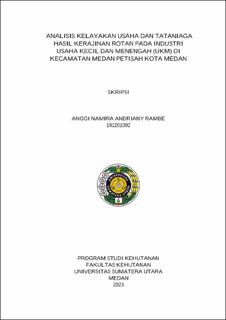| dc.description.abstract | Rattan holds high economic value, as evidenced by its contribution to the income of local communities. In the Medan Petisah Sub District of Medan City, there are businesses engaged in rattan craft trade, which fall under the category of small and medium-sized enterprises (SMEs) that focus on processing rattan into various types of crafts. This research aims to investigate the business development profile, feasibility of these enterprises, the trading network, and marketing strategies for SMEs in the rattan craft industry. Sampling was conducted using a census technique, covering five rattan craft SMEs in the Medan Petisah Subdistrict. Data collection methods employed in this study included observation, interviews, and questionnaires. All five SMEs were found to be financially viable, which is consistent with the research findings showing that NPV > 0, IRR > the interest rate, and BCR > 1. The trading network involved various stakeholders, including rattan farmers, collectors, wholesalers, and rattan craftsmen. Within this network, three key functions were identified: exchange function, physical function, and facilitation function. The market structure at the rattan farming level was identified as oligopoly, while at the rattan craftsmen level, it resembled a perfect competition. The trade channels span from rattan farmers in Aceh, Padang, and Kalimantan as producers to rattan craftsmen as end consumers. Market behavior within the trading network included branding, product innovation, marketing and promotion, as well as building partnerships with raw material suppliers, distribution partners, and relevant government agencies. The rattan craft industries in the Medan Petisah Subdistrict fall into quadrant I. In this situation, the recommended strategy is to adopt an aggressive growth-oriented approach (Growth-Oriented Strategy). Therefore, several strategies can be formulated by combining internal and external factors, namely S-O (Strengths-Opportunities) Strategies. | en_US |


